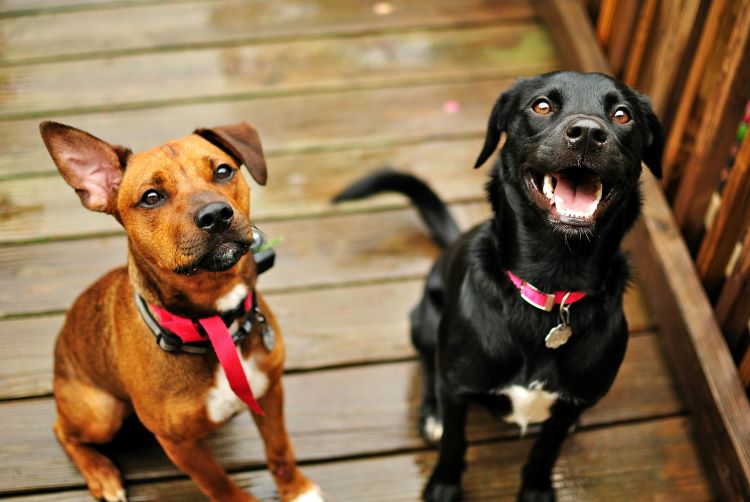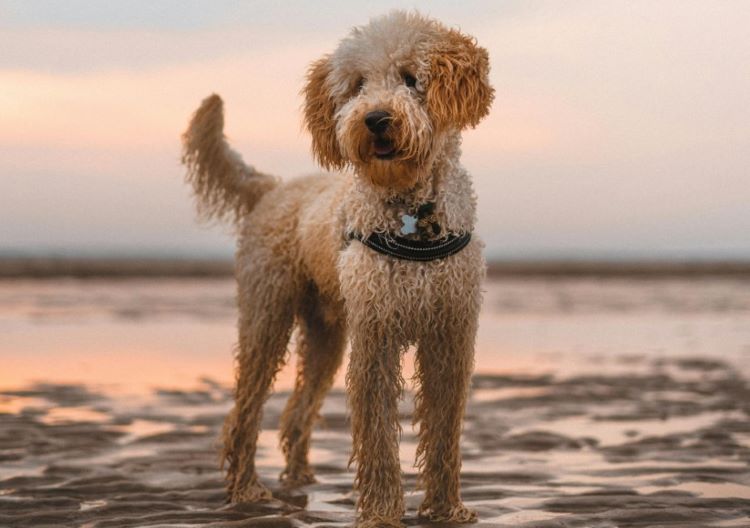Ready to help treat your pet to a healthy life?
All About Mixed Breed Dogs
By : Trupanion Staff | Updated Sep 9, 2024

Your dog doesn't quite look like other dogs. They may have similarities to certain breeds, but they don't appear to belong to any specific one. So, what are they? While only a canine DNA test or experienced veterinarian will be able to tell for sure, there's a good chance they're a mixed breed dog!
Mixed breed dogs, often called "mutts" (though this term is becoming less common) are a wonderful blend of various breeds. Combining unique traits from their diverse ancestry, these dogs come in all shapes, sizes, and temperaments. This makes them a versatile and appealing choice for many pet owners. While they may not have a purebred pedigree, mixed breed dogs are often healthier due to genetic diversity and can display the best qualities of multiple breeds. As dog lovers at Trupanion, we've put together this guide to help you understand the benefits of owning a mixed breed dog, how to care for them, and what to expect in terms of behavior, health, and training.
Fun facts about mixed breed dogs
- National Mutt Day (also called National Mixed Breed Dog Day) is celebrated twice a year in the United States — July 31st and December 2nd.
- In 2010, Mars Veterinary held a National Mutt Census in the United States. They found the top three most common breeds in the mixed breed dog category were 1. German Shepherd, 2. Labrador Retriever, and 3. Chow Chow. These trends reflected popular purebred dog breeds in the country around that time.
- It is commonly believed that mixed breed dogs, and some “designer breeds” (like doodles), are generally healthier and live longer than their purebred counterparts. This theory is called “hybrid vigor.” The thought is that by mixing different breeds who have varying risks for different genetic disorders, you can get a resulting dog that has an overall lower risk for genetic disorders than the parent breeds.
- A crossbreed dog is different than a mixed breed dog. A crossbreed is when a puppy is a result of breeding two purebred dogs whose family lines can be traced back through the generations. A mixed breed dog, on the other hand, has unknown origins or history. While you can more reliably predict the temperament and traits of a crossbred dog, it is much harder in a mixed breed dog, especially because of the inability to predict recessive genes.
- According to a 2015 study by the National Animal Interest Alliance, only 5% of dogs available for adoption from shelters were purebred, meaning 95% of puppies and dogs up for adoption were mixed breeds or crossbreeds! A more recent study by The Humane Society showed that over 50% of all dogs are mixed.
Understanding mixed breed dogs
A mixed-breed dog’s personality will be as unique as each individual dog. Some are more reserved and quiet, while others are a chatterbox willing to entertain with their goofy antics for hours. Some mixed breeds will exhibit protective characteristics and might make excellent guard dogs, while others might be so sociable and love everybody so much that they’d help the thief pack up your valuables (as long as they got a tummy rub as payment). Whether you’re looking for the quiet and mysterious bookworm, the class clown, or the jock, there is a mixed breed dog with a perfect personality match for you.
History
Dogs are believed to have been domesticated about 14,000 years ago, and since they first came into our lives, humans have been selectively breeding them (or at least taking advantage of natural breeding between dogs) to perform certain jobs. This cooperation between species has meant the success of both dogs and humans.
A mixed breed is defined as a dog from unintentional breeding, with mostly unknown ancestry. And they’ve been around since before there were recognized dog breeds at all. Before humans began intentionally breeding certain dogs with each other to strengthen either physical or behavioral characteristics, the mixed breed was there. It was from this group of “breedless” dogs that we began picking and choosing certain tendencies and expressions of genes that we molded into recognizable dog breeds with traceable lineages.
There are mixed breeds of dogs all around the world today. If humans were suddenly to stop intentionally breeding dogs, and the dogs were left to their own devices, within a few generations all puppies and dogs would be considered mixed breed. Often called “mutts,” they are a favorite of many dog owners and are just as loving and lovable as any other breed of dog.
What's the difference between 'mixed,' 'mutt,' and 'designer' dogs?
Though the terms are often used interchangeably, there are some distinctions. "Mixed breed," "mutt," and "designer dog" refer to different types of dogs with diverse genetic backgrounds:
- Mixed breed — A dog with ancestry from two or more different breeds, often without any intentional breeding. Their genetics are typically a random combination of several breeds, and their characteristics can vary greatly.
- Mutt — A colloquial term for mixed breed dogs. It generally refers to dogs of uncertain ancestry, often with a mix of multiple breeds over generations. As mentioned earlier, this specific terminology is becoming less common.
- Designer dog — A cross between two purebred dogs intentionally bred for specific traits (e.g., Goldendoodle — Golden Retriever and Poodle). Designer dogs are purposefully mixed to combine desirable qualities from each breed.

Behavior and training
Every dog, no matter the breed mix, does best with consistent positive reinforcement training. Many love working for food (who doesn’t?), but also find toys and play with their human very rewarding.
Training myths vs. facts
Many people describe certain dogs as being “stubborn” and hard to train, or a dog that needs a “heavy hand.” Fortunately, scientific studies have shown that, in fact, every dog learns faster and better using positive reinforcement methods (such as clicker training) and by avoiding the use of intimidation, pain, or threat of pain (such as a shock collar or prong collar). These outdated punishment-based methods have been proven to actually damage the human-canine relationship and can increase aggressive responses in dogs — the exact opposite of what we want.
It all comes down to knowing what motivates a dog and using that to your advantage. With positive reinforcement training methods and consistency, every dog is a joy to train and will be an excellent companion. Punishments, whether verbal or physical, not only damage the relationship between a mixed-breed and their owner but also tend not to work in the long run. Often, it creates long-term behavioral issues. By focusing on teaching your dog what to do, rather than on unwanted behaviors, they will be well-behaved sidekicks for life!
How well do mixed breed dogs get along with others?
Positive, proactive exposure to new sights, sounds, people, dogs, and other animals as a young puppy is essential for a dog’s future socialization skills.
Living with or being around children can be tough for a dog of any breed or breed mix. Take care to introduce and socialize them with children as a young puppy to set them up for success and create a positive association. Young children and dogs should always be supervised, and it’s helpful for a dog to have their own “safe space” where they can go when they need some quiet time.
Living with other pets in the home can be difficult for a dog of any breed or breed mix. Many dogs can enjoy the companionship of other animals in the home, as long as they have been properly socialized and introduced. However, some breed mixes have a tendency to chase prey more than others, such as hound mixes, spitz or Nordic breed mixes, and herding breed mixes. Make sure to match any potential new mixed breed with your current pets and have proper and positive introductions.
Exercise requirements
A dog’s size and energy level determine the amount of daily exercise needed, and a mixed breed will benefit from different types of physical activity beyond just a daily walk. Play is an important way to exercise your dog and build your bond at the same time (not to mention get some training practice in!). Speak with your veterinarian about the appropriate amount of exercise for your dog’s size, energy level, weight, and age. And any time you want to increase the amount of physical exercise you do with your pup (looking at you Couch-to-5K’ers), make sure to have a vet check first and ease them into it.
Speak with your veterinarian about appropriate exercise for a puppy. Until they are full-grown (bone growth plates typically all close by around 1 year of age, depending on the dog’s size – longer for larger breeds), avoid strenuous or repetitive activities like jogging or running, as this can possibly increase their risk of damage to the growing bone and cartilage and cause pain and future joint issues.
Mental enrichment needs
Every dog needs daily mental stimulation and brain games to keep them happy and entertained. Participating in positive reinforcement training for obedience or teaching tricks is a fantastic way to burn extra energy and further build the canine-human bond. Providing natural outlets for instinctual drives, such as digging and chewing, will help prevent destructive chewing or digging in your flower beds.
Common behavioral issues
Due to their love of companionship, many dogs need positive exposure to alone time from a young age to help prevent or minimize any separation anxiety from developing. It’s much easier to prevent than to treat once it’s started. Make alone time a positive and relaxing experience for your dog.
Potential activities for mixed breed dogs
Because mixed pups have such diverse ancestry, they come in all shapes, sizes, and energy levels. Take stock of what your dog seems to enjoy doing, and choose a dog sport or activity based on their natural talents. Do they follow their nose everywhere? Maybe tracking or search and rescue is for them! Do they love water? Check out dock diving!
Here’s a list of different dog-centric activities to check out:
- Search and Rescue
- Tracking
- Nose Work
- Earth Dog
- Barn Hunt
- Canine Musical Freestyle
- Rally Obedience
- Agility
- Flyball
- Conformation (dog shows)
- Dock Diving
- Joring
- Sled Pulling
- Carting
- Schutzhund Training
- Disc dog
- Herding
- Treibball
- Parkour
- Skateboarding/Surfing
Grooming and care
It depends! A mixed breed puppy’s coat type will be determined by its parents (or often even further back genetics-wise, since many longhair genes are recessive). Dog coats can range from mostly hairless, to smooth short single-coats, to curly, wiry, or short double-coats, to longer double-coats. The variety of dog fur provides an option for every person’s preference, whether you’re looking for glossy, long and flowing, perfectly coiffed, or extra, extra fluffy!
No matter the type of coat your dog has, it’s important to keep it properly maintained. While short and smooth coats don’t require as much daily maintenance as longer double-coated dogs, it’s important to keep every dog’s coat clean of dirt, brushed out to keep it free of mats and maintain airflow over the dog’s skin, and regularly trimmed if needed.
Basic grooming care also includes frequent nail trimming (don’t forget the dewclaws if your mixed breed has them!).
A puppy as young as 12 weeks can be introduced to professional grooming, whether at a grooming salon or scheduling a mobile groomer to come to your home. You’ll want to make sure the facility is clean, your puppy is kept separate from other dogs, and they are up to date on vaccinations and parasite preventatives (be sure to check with your vet first). Caretakers can introduce different grooming tools (such as brushes, nail trimmers, and clippers) and handle them in a positive way as young as 5 weeks old. Owners can continue this proactive exposure training when they bring the puppy home.

Mixed breed dogs in pop culture
The variety of these dogs means they can fit in well in a wide range of environments, including in media. In fact, you've likely seen a lot of mixed breed dogs in art, TV, movies, and in photos with celebrities over the years.
Famous owners of mixed breed dogs
- Orlando Bloom (Actor)
- Anne Hathaway (Actress)
- Olivia Munn (Actress)
- Jane Lynch (Actress)
- Miley Cyrus (Singer)
- Kellan Lutz (Actor)
- Ian Somerhalder and Nikki Reed (Actors)
- Kaley Cuoco (Actress)
- Kelly Clarkson (Singer/TV Host)
- Ruby Rose (Model/Actress)
Famous mixed breed dogs
- Higgins was a spaniel mix most famous for starring as Benji during the 1970s, but also had big roles in Petticoat Junction, Green Acres, and The Beverly Hillbillies
- Star of the 1957 film Old Yeller, Spike
- Laika the space dog became the first animal to orbit the Earth
